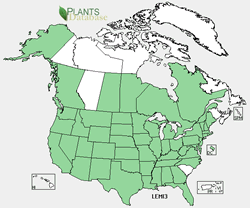Plant of the Week
 Lemna minor range map. USDA PLANTS Database.
Lemna minor range map. USDA PLANTS Database.
 Lemna minor thalli floating in slow-moving water.Photo by Robert H Mohlenbrock.
Lemna minor thalli floating in slow-moving water.Photo by Robert H Mohlenbrock.
 Lemna minor thalli on surface of small pond in the Tushar Mountains of southern Utah. Photo by Bill Gray, Salt Lake City, Utah.
Lemna minor thalli on surface of small pond in the Tushar Mountains of southern Utah. Photo by Bill Gray, Salt Lake City, Utah.
Common duckweed (Lemna minor)
By Walter Fertig
The duckweeds (genus Lemna) and related genera of the duckweed family (Lemnaceae) are the smallest flowering plants known. Individual plants consist of a single, flat oval leaf (technically a modified stem) no more than ¼ of an inch long that floats on the surface of still-moving ponds, lakes, and sloughs. The duckweed inflorescence, consisting of two microscopic staminate flowers and one tiny pistillate flower in a pouch-like sac, is almost never seen. Taxonomists believe the duckweed flowers are modified versions of the familiar leafy spathe and club-like spadix of the skunk cabbages, Jack-in-the-pulpit, calla lilies, and other members of the Arum family (Araceae), and indeed recent genetic studies suggest that duckweeds probably belong in an expanded version of the Arum family. Despite their diminutive size, the flowers of duckweeds can attract flies, mites, small spiders, and even bees that can spread the plant’s pollen after being attracted by sticky secretions from the stigma. Duckweeds can also be “contact pollinated” through the collision of adjacent floating stems that jars pollen loose and on to the receptive stigma.
However, sexual reproduction is the exception rather than the rule in duckweeds. More often, species propagate asexually by forming chains of new stems from vegetative buds. Some duckweed can also produce specialized buds called turions that break off the parental stem and sink to the bottom of a lake or pond to over-winter. In spring, the starch-filled turions rapidly begin to metabolize, causing the structure to float back to the surface and grow into a typical duckweed stem.
Duckweeds grow quickly and produce new offshoots rapidly. Dense populations are an important food source for aquatic waterfowl and fish, but can become a nuisance to humans. Scientists have recently come to appreciate the fast growth rate of duckweeds, however, and the plants are being used for bioremediation of waterways with excessive amounts of phosphorus and nitrogen from agricultural runoff. Harvesting duckweeds as a crop can remove these pollutants and provide valuable livestock feed or fertilizer. Researchers are also developing techniques to use genetically modified duckweeds to synthesize insulin and other commercially valuable proteins (being plants, duckweeds are immune to animal viruses, making them invaluable in creating new biomedicines).
Nine duckweed species occur in North America. Common duckweed (L. minor) is the most widespread species, ranging across Canada and reported for all states except Hawaii and South Carolina. Identifying duckweeds to species can be tricky due to their minute size and absence of showy floral characters. Stem size and the number of roots (if any) distinguish other genera in the duckweed family.

